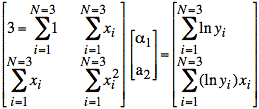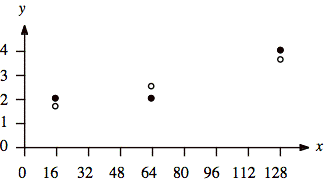|
|
By: Neil E. Cotter |
Regression |
|
|
|
Least squares method |
|
|
|
Example 1 |
|
|
|
|
|
|
|
|
Ex: Find a way to fit three data points, with an exponential curve:
![]()
where
(x1, y1) = (16, 2) (x2, y2) = (64, 2) (x1, y1) = (128, 4)

Here, we have ![]() since
since ![]() is one-dimensional.
is one-dimensional.
We proceed by calculating derivatives:


Next, we solve  :
:

and

or

and

At this point, the idea is to take the coefficients, a1 and a2, outside the summations. Here, we can take a1 outside:

and

Our goal is to have summations involving only the data. Unfortunately, we are unable to extract a2 from the summations. Thus, this direct approach fails to yield a simple solution. We might try to use an iterative method, but this adds considerable complexity.
An alternative approach is to take logarithms of data points and the model function:
![]()
Note: We have chosen to change the problem we are solving so we can apply the least-squares method in a straightforward way.
We set derivatives to zero:
![]()
We proceed by calculating the derivatives:

and

We can now take coefficients outside of the summations:
 or
or 
and

We define α1 to simplify the appearance of our equations:
α1 ≡ ln a1
Writing the equations in matrix form, we have the following result:

or in symbolic form:
![]()
Our solution in matrix notation is obtained by multiplying both sides by X−1:
![]()
Using the numerical data provided in the problem, we have the following calculation:

or

or

or

or
![]() , a2 = 0.00644
, a2 = 0.00644
or
![]()
For the data points, we get the following y values:
![]()
![]()
![]()
